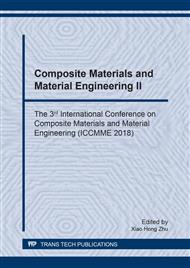p.215
p.221
p.229
p.235
p.243
p.249
p.257
p.263
p.269
Effect of Varied Layer-Content/Thickness on Ballistic Performance of a Functionally Graded Al2O3/ZrO2 Material
Abstract:
This study compared the ballistic performance of alumina (Al2O3)/ zirconia (ZrO2) functionally graded material (FGM) specimens with various levels of thickness and ZrO2 content and a pure Al2O3 single-layer ceramic composite (PCM). Ballistic tests were conducted with 0.3-inch armor-piercing (AP) projectiles, and finite element code LS-DYNA was used to examine energy absorption, stress distribution, and ceramic cone failure in the specimens. The findings are as follows: First, regarding energy absorption per unit of areal density, the 5% FGMs had the highest ballistic performance, which increased by up to 8%. By contrast, the ballistic performance of the 15% FGMs declined significantly to lower than that of the PCM. Second, the capability of the ceramic cone to withstand stress damage and projectiles was significantly greater in the 5% FGMs than in the 15% FGMs. Third, the wave impedance variations increased with the ZrO2 content in each layer, thereby enhancing the interactions between impact waves and aggravating ceramic damage. Thus, the intensities of transmission and reflection waves in the 15% FGMs increased, thereby causing reductions in its ballistic performance.
Info:
Periodical:
Pages:
243-248
Citation:
Online since:
August 2018
Authors:
Keywords:
Price:
Сopyright:
© 2018 Trans Tech Publications Ltd. All Rights Reserved
Share:
Citation:


